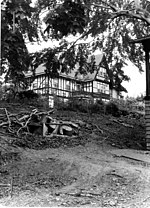Worcester Polytechnic Institute

Worcester Polytechnic Institute (WPI) is a private research university in Worcester, Massachusetts. Founded in 1865 in Worcester, WPI was one of the United States' first engineering and technology universities and now has 14 academic departments with over 50 undergraduate and graduate degree programs in science, engineering, technology, management, the social sciences, and the humanities and arts, leading to bachelor's, master's and PhD degrees. WPI's faculty works with students in a number of research areas, including biotechnology, fuel cells, information security, surface metrology, materials processing, and nanotechnology. It is classified among "R2: Doctoral Universities – High research activity".
Excerpt from the Wikipedia article Worcester Polytechnic Institute (License: CC BY-SA 3.0, Authors, Images).Worcester Polytechnic Institute
Institute Road, Worcester
Geographical coordinates (GPS) Address External links Nearby Places Show on map
Geographical coordinates (GPS)
| Latitude | Longitude |
|---|---|
| N 42.274444444444 ° | E -71.8075 ° |
Address
Worcester Polytechnic Institute (WPI)
Institute Road 100
01609 Worcester
Massachusetts, United States
Open on Google Maps










